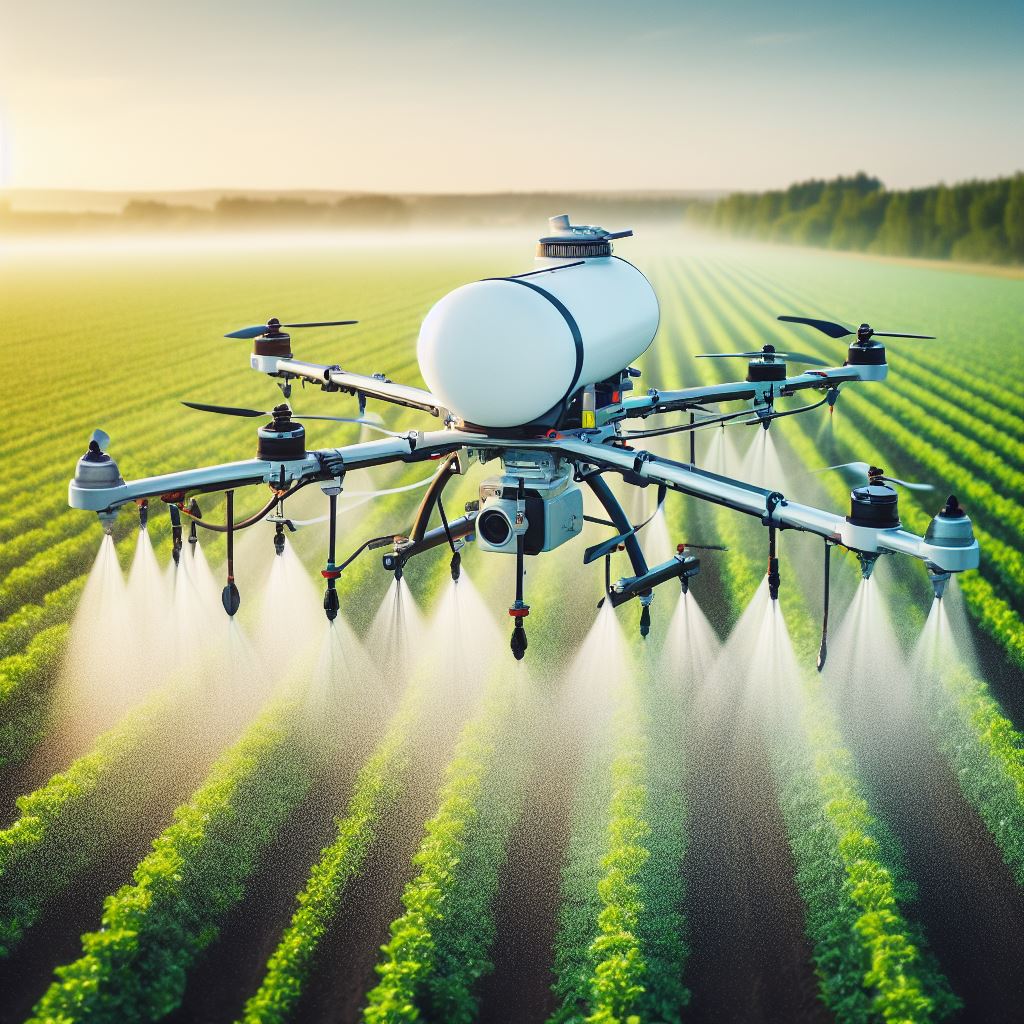Introduction
A. Farming in the Digital Age
Farming has transcended traditional methods, embracing digital technologies for efficiency and sustainability.
From precision agriculture to data-driven decisions, the digital era is reshaping the agricultural landscape.
B. Importance and Relevance
- Precision Agriculture: Digital tools enhance crop management, optimizing resources and minimizing environmental impact.
- Smart Equipment: Innovations like GPS-guided tractors and drones improve efficiency, reducing labor and costs.
- Data Analytics: Farmers harness big data to make informed decisions, from planting to harvest, boosting productivity.
- Sustainability: Digital farming promotes eco-friendly practices, ensuring long-term viability in a changing climate.
- Global Connectivity: Farmers can access markets, trends, and expertise globally, fostering collaboration and knowledge exchange.
Embracing this digital shift is not just a choice but a necessity for the future of agriculture, fostering sustainability, efficiency, and global connectivity in feeding our growing population.
Evolution of Farming Techniques
A. Traditional farming methods and challenges faced
Traditional farming methods have been practiced for centuries, relying on manual labor and basic tools.
Farmers faced numerous challenges, such as unpredictable weather patterns and pests damaging crops.
Lack of access to information and limited communication channels made it difficult to overcome these challenges.
The manual nature of traditional methods required significant physical strength and labor, leading to fatigue.
Traditional farming also lacked precision, resulting in uneven crop growth and reduced yields.
Farmers had limited control over irrigation, leading to water wastage or inadequate supply for crops.
Soil erosion due to tillage and inappropriate irrigation methods threatened the long-term productivity of farmland.
Additionally, traditional farming methods did not facilitate efficient resource management, increasing costs.
B. Technological advancements in farming
- Technological advancements have revolutionized farming and overcome many challenges.
- Farming machinery, such as tractors and harvesters, increased efficiency and reduced manual labor.
- Improved irrigation systems like sprinklers and drip irrigation ensure precise water distribution.
- Weather forecasting and monitoring tools provide valuable information for better planning and decision-making.
- Precision agriculture techniques, such as satellite imagery and GPS, enable accurate crop monitoring and management.
- Genetic engineering has led to the development of disease-resistant and high-yielding crop varieties.
- Robotic technology, including autonomous drones and robotic harvesters, improve efficiency and reduce labor costs.
- Remote sensing technology helps identify crop stress, enabling timely intervention and minimizing crop loss.
C. The benefits of incorporating digital tools in agriculture
- Incorporating digital tools in agriculture can significantly improve productivity and sustainability.
- Access to real-time data and analytics allows farmers to make informed decisions and optimize resource allocation.
- Digital tools help monitor crop growth, detect diseases and pests early, and take preventive measures.
- Efficient irrigation systems based on data analysis conserve water and minimize wastage.
- Precision agriculture techniques reduce the use of fertilizers, pesticides, and herbicides, reducing environmental impact.
- Digital tools enable better inventory management, reducing post-harvest losses and ensuring food security.
- Integration of automation and robotics increases efficiency, reduces labor costs, and enhances overall farm productivity.
- By adopting digital tools, farmers can enhance their competitiveness, improve profitability, and achieve long-term sustainability.
In fact, the evolution of farming techniques has witnessed a shift from traditional methods to incorporating digital tools.
Traditional farming faced challenges related to labor, resource management, and inefficient practices.
However, technological advancements have revolutionized agriculture by facilitating precision, efficiency, and sustainability.
Incorporating digital tools in farming offers numerous benefits, from better decision-making and resource allocation to improved crop monitoring and reduced environmental impact.
Transform Your Agribusiness
Unlock your farm's potential with expert advice tailored to your needs. Get actionable steps that drive real results.
Get StartedEmbracing the digital age in agriculture can empower farmers to overcome challenges, increase productivity, and ensure food security for future generations.
Digital Tools for Farm Management
A. Precision Agriculture and Use of GPS Technology
Precision agriculture, enabled by GPS technology, revolutionizes farming practices and maximizes crop yield.
Farmers can precisely monitor and control the application of fertilizers and pesticides, minimizing waste.
GPS-enabled machinery ensures accurate planting, harvesting, and irrigation, reducing human error and saving time.
B. Farm Management Software for Planning and Decision-Making
Farm management software assists farmers in effectively planning and making critical decisions for their operations.
With features like crop rotation scheduling, yield mapping, and financial analysis, farmers can optimize productivity and profitability.
These tools provide valuable insights and help in monitoring the performance of crops and livestock, ensuring better outcomes.
C. Internet of Things (IoT) Applications in Farming
The Internet of Things has become a game-changer in farm management, offering endless possibilities.
Sensors, connected to the internet, enable real-time data collection on soil moisture, temperature, and livestock behavior.
By analyzing this data, farmers can make informed decisions regarding irrigation, pest control, and animal health.
D. Examples of Digital Tools Utilized in Livestock, Crop Cultivation, and Dairy Farming
1. Livestock Farming
- Smart collars equipped with sensors monitor the health and behavior of animals, alerting farmers of any abnormality.
- Automated feeding systems dispense the right amount of feed at the right time, optimizing animal nutrition.
- Remote-controlled milking robots streamline dairy farming, improving efficiency and reducing labor-intensive tasks.
2. Crop Cultivation
- Drones equipped with multispectral cameras capture images of crops, identifying areas of nutrient deficiency or pest infestations.
- Automated irrigation systems regulate water supply based on real-time weather and soil conditions, conserving water resources.
- Weather forecasting apps help farmers plan their activities and make informed decisions regarding planting and harvesting.
3. Dairy Farming
- IoT-enabled systems monitor milk production, ensuring early detection of any issues and maintaining milk quality.
- Automated manure management systems collect and process livestock waste, reducing environmental impact.
- Wearable devices, like activity trackers for cows, provide insights into their health and reproductive status, leading to better breeding practices.
In essence, the digital age has brought forth an array of powerful tools that have transformed farm management.
Precision agriculture, farm management software, IoT applications, and various digital tools have revolutionized farming practices.
From livestock farming to crop cultivation and dairy farming, these tools have allowed farmers to enhance productivity and achieve sustainable agriculture.
Read: Permaculture Basics: Nature’s Way in Agriculture
Access to Agricultural Information
In today’s digital age, access to agricultural information has greatly improved due to the internet.
A. Role of the internet in bridging the information gap
The internet plays a crucial role in bridging the information gap in farming.
Farmers can now easily access a vast amount of information through online sources.
They can learn about the latest farming techniques, research, and advancements in the industry.
Online platforms provide a wealth of knowledge that was previously difficult to obtain.
Through the internet, farmers can access information on weather patterns, crop diseases, and pest control.
The internet enables farmers to make informed decisions and adapt their farming practices accordingly.
It also helps farmers stay updated with market trends and pricing information.
With access to agricultural information, farmers can maximize their productivity and profitability.
They can make better planning and management decisions, leading to more efficient farming practices.
Showcase Your Farming Business
Publish your professional farming services profile on our blog for a one-time fee of $200 and reach a dedicated audience of farmers and agribusiness owners.
Publish Your ProfileThe internet has revolutionized the way farmers access and utilize agricultural information.
B. Online platforms for farmers to access knowledge and expertise
Various online platforms have been developed specifically for farmers to access knowledge and expertise.
These platforms provide a space for farmers to connect, share expertise, and exchange ideas.
Farmers can join online forums and communities to discuss farming issues and seek advice.
They can connect with experts and specialists in different fields of agriculture.
Online platforms also offer resources such as articles, videos, and tutorials on various farming topics.
These platforms facilitate peer learning and collaboration among farmers, fostering a sense of community.
Farmers can benefit from the collective wisdom and experiences shared on these platforms.
Online platforms enable farmers to stay updated with the latest farming practices and technologies.
They can learn from successful farmers and industry professionals who share their knowledge online.
By accessing knowledge and expertise online, farmers can enhance their skills and improve their farming practices.
C. Availability of online courses and webinars for skill enhancement
One of the greatest advantages of the internet is the availability of online courses and webinars.
Farmers can enroll in online courses to enhance their skills and knowledge in specific areas of farming.
These courses cover a wide range of topics, including crop management, livestock care, and sustainable farming.
Webinars allow farmers to participate in interactive online workshops and seminars.
They can learn from experts in real-time and have their questions answered instantly.
This accessibility to online courses and webinars eliminates the need for farmers to travel long distances.
It also saves them time and costs associated with attending physical training sessions.
Online courses and webinars offer flexibility, allowing farmers to learn at their own pace.
Through these resources, farmers can gain in-depth knowledge and stay updated with the latest industry practices.
Continuous learning and skill enhancement through online courses contribute to the overall progress of farming.
In brief, the internet has revolutionized access to agricultural information for farmers.
Online platforms, courses, and webinars have bridged the information gap, providing farmers with a wealth of knowledge and expertise.
With easy access to information, farmers can make informed decisions, improve their practices, and ultimately enhance their productivity and profitability.
The digital age has truly empowered farmers to embrace new techniques and technologies to achieve sustainable and successful farming.
Read: Agroforestry: Combining Trees and Crops Wisely

Read: Maximizing Profit: Selling Your Farm Land Wisely
Impact of Data Analysis and AI in Farming
A. Utilizing data to optimize crop yield and minimize resource usage
- Data analysis helps farmers identify patterns and trends that can improve their crop production.
- By analyzing data from sensors and satellite imagery, farmers can make informed decisions about when to plant and harvest their crops.
- Data analysis also allows farmers to optimize the use of resources such as water and fertilizers, reducing waste and cost.
- Through real-time monitoring, farmers can adjust irrigation systems and nutrient application based on the specific needs of their crops.
- This data-driven approach helps increase crop yield, improve quality, and minimize the negative impact on the environment.
B. Applying machine learning algorithms for disease detection and prevention
- Machine learning algorithms can analyze large datasets to identify early signs of crop diseases.
- By using image recognition technology, algorithms can detect visual symptoms and patterns associated with different diseases.
- Early detection allows farmers to take immediate action, preventing the spread of diseases and minimizing crop losses.
- Machine learning algorithms can also predict disease outbreaks based on weather patterns and historical data.
- This proactive approach enables farmers to apply preventive measures in a timely manner, reducing the need for pesticides.
C. Benefits of predictive analytics in better decision-making
- Predictive analytics uses historical data to forecast future outcomes and make informed decisions.
- In farming, predictive analytics can help farmers determine the best time to sow seeds, apply fertilizers, and harvest crops.
- By considering various factors such as weather forecasts, market demand, and soil conditions, farmers can optimize their strategies.
- Accurate predictions reduce the risk of crop failure, optimize resource allocation, and increase profitability.
- Farmers can also use predictive analytics to optimize logistics, plan storage capacity, and manage supply chains efficiently.
In general, data analysis and AI have brought significant advancements to the field of farming.
By utilizing data to optimize crop yield and minimize resource usage, farmers can increase productivity while reducing environmental impact.
Applying machine learning algorithms for disease detection and prevention helps farmers prevent crop losses and minimize pesticide use.
Lastly, predictive analytics empowers farmers to make better decisions by forecasting future outcomes and optimizing their strategies.
Overall, the impact of data analysis and AI in farming is transformative, driving the industry toward a more efficient and sustainable future.
Read: Urban Farming: Growing Food in City Spaces
Challenges and Concerns in the Digital Age
A. Initial investment and cost considerations
One of the major challenges for farmers in embracing digital farming practices is the initial investment required.
Not all farmers can afford to purchase the necessary equipment and technologies.
The cost of sensors, drones, and other technologies can be prohibitive for small-scale farmers.
Moreover, adopting digital farming practices often requires upgrading existing infrastructure, such as irrigation systems and machinery.
This can add to the financial burden and make it difficult for farmers to take the first step.
However, there are initiatives and government programs that aim to provide financial support and incentives to farmers who want to adopt digital farming technologies.
These programs can help alleviate the initial investment concerns and make digital farming more accessible to a wider range of farmers.
Showcase Your Farming Business
Publish your professional farming services profile on our blog for a one-time fee of $200 and reach a dedicated audience of farmers and agribusiness owners.
Publish Your ProfileB. Farmers’ learning curve and digital literacy
An important challenge in the digital age is the learning curve that farmers face when adopting new technologies.
Many farmers have limited experience or knowledge of digital tools and platforms.
Therefore, they need to invest time and effort in learning how to use these technologies effectively.
Additionally, older farmers who have been farming for decades may be resistant to change and hesitant to embrace digital farming practices.
They may find it challenging to adapt to new technologies and may require assistance or training to build their digital literacy skills.
Addressing these challenges requires educational programs and training initiatives that provide farmers with the necessary skills and knowledge to navigate the digital landscape.
Supporting farmers in building their digital literacy can help them optimize their farming practices and benefit from the digital age.
C. Data privacy and security concerns
The digitization of farming also raises concerns about data privacy and security.
Farmers collect a vast amount of data about their operations, including crop yields, soil conditions, and weather patterns.
This data is highly valuable and needs to be protected from unauthorized access or misuse.
Farmers need to ensure that their data is stored securely and that they have control over who can access it.
There is a need for reliable and robust cybersecurity measures to safeguard sensitive farming data.
Additionally, there is a risk of data breaches or hacking incidents that could disrupt farm operations or compromise confidential information.
Farmers must be proactive in implementing security protocols and staying updated on the latest cybersecurity practices.
D. The digital divide in rural areas and access to technology
One of the critical concerns in the digital age of farming is the digital divide that exists in rural areas.
Not all farmers have the same level of access to technology and high-speed internet. This hinders their ability to fully embrace digital farming practices.
Rural areas often have limited or unreliable internet connectivity, making it challenging for farmers to access online resources, data analysis tools, or farming apps.
This creates a technological gap between urban and rural farmers, limiting the potential benefits of digital farming for rural communities.
Addressing the digital divide requires investment in rural internet infrastructure and policies that promote equal access to technology for all farmers.
Efforts should be made to bridge the gap and ensure that rural farmers are not left behind in the digital transformation of agriculture.
In a nutshell, while digital farming offers numerous benefits, there are several challenges and concerns that need to be addressed.
The initial investment costs, farmers’ learning curve, data privacy, and the digital divide all pose obstacles to the widespread adoption of digital technologies in agriculture.
However, with targeted support, training programs, and infrastructure development, these challenges can be overcome, and farmers can reap the rewards of farming in the digital age.
Read: Organic Farming: A Path to Sustainable Future
Success Stories and Case Studies
A. Successful Farming Ventures Utilizing Digital Tools
- Farmer John, using precision agriculture techniques, increased his crop yield by 20%.
- Jane, a small-scale farmer, implemented automated irrigation systems and saw a significant reduction in water usage.
- The Smiths utilized drones to monitor their livestock and detect diseases early, leading to healthier animals and increased profits.
- Tom incorporated machine learning algorithms to analyze weather patterns and optimize his planting schedule, resulting in more accurate predictions and higher crop quality.
- Emily, a dairy farmer, implemented a digital tracking system for cow health, leading to early detection of issues and improved milk production.
B. Positive Outcomes and Improvements Achieved
These success stories demonstrate how digital tools can revolutionize farming practices, leading to increased productivity and profitability.
By leveraging data analytics and automation, farmers can make informed decisions and streamline operations, saving time and resources.
Digital farming tools also enable farmers to monitor and manage their crops and livestock more efficiently, resulting in better yield and animal health.
Reduced water usage and early disease detection contribute to sustainability and environmental stewardship in agriculture.
The incorporation of artificial intelligence and machine learning technologies optimizes resource allocation, minimizing waste and maximizing efficiency.
C. Real-Life Examples of Digital Farming Success
These success stories show that embracing digital tools can transform traditional farming into a cutting-edge industry.
Farmers who adopt digital solutions can overcome challenges and achieve remarkable improvements in their operations.
The stories highlight the potential for innovation and growth in agriculture, inspiring readers to explore digital farming opportunities.
By showcasing real-life examples, readers can envision the benefits and potential impact of integrating digital tools into their own farm practices.
Through these success stories, farmers are encouraged to embrace technology and join the digital revolution in agriculture.
In summary, digital tools have revolutionized farming practices, leading to successful farming ventures and positive outcomes.
Farmers utilizing precision agriculture techniques, automated systems, drones, machine learning algorithms, and digital tracking systems have experienced significant improvements in crop yield, animal health, resource management, and profitability.
These success stories inspire readers by providing real-life examples of digital farming success and highlighting the transformative potential of digital tools in agriculture.
By adopting digital solutions, farmers can overcome challenges, streamline operations, and embrace the opportunities for innovation and growth in the digital age of farming.
Conclusion
Digital technology has revolutionized the agricultural industry.
We explored how farmers can benefit from embracing digital tools such as precision farming, data analytics, and smart sensors.
Showcase Your Farming Business
Publish your professional farming services profile on our blog for a one-time fee of $200 and reach a dedicated audience of farmers and agribusiness owners.
Publish Your ProfileThese tools enable farmers to make informed decisions, optimize resource usage, and increase crop yields.
The importance of adopting digital tools in modern farming cannot be overstated.
With real-time data and analytics, farmers can monitor and manage their crops and livestock more efficiently.
This leads to lower production costs, reduced waste, and improved environmental sustainability.
We encourage readers to explore and implement digital solutions on their farms.
Whether it’s using drones for crop monitoring, utilizing automated irrigation systems, or implementing smart farm management platforms, embracing digital tools can greatly enhance farm operations.
By leveraging digital technology, farmers can become more proactive in their decision-making process.
They can identify potential issues before they become major problems, leading to increased productivity and profitability.
It is essential for farmers to stay updated with the latest advancements in digital farming and continuously adapt their practices.
The future of agriculture lies in embracing digital tools and harnessing their potential benefits.
By doing so, farmers can improve their farm management, increase their yields, and contribute to a more sustainable and efficient agricultural industry.




